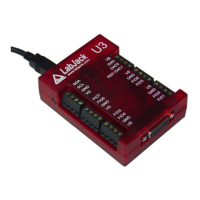damaging the U3, but more thought is required to determine what is necessary to make useful
measurements with the U3 or any measurement device.
Voltage (versus ground): The single-ended analog inputs on the U3 measure a voltage with
respect to U3 ground. The differential inputs measure the voltage difference between two
hannels, but the voltage on each channel with respect to
c ground must still be within the
e,
common mode limits specified in Appendix A. When measuring parameters other than voltag
or voltages too big or too small for the U3, some sort of sensor or transducer is required to
produce the proper voltage signal. Examples are a temperature sensor, amplifier, resistive
voltage divider, or perhaps a combination of such things.
Impedance: When connecting the U3, or any measuring device, to a signal source, it must b
considered what impact the measuring device will have on the signal. The main consideratio
whether the currents going into or out of the U3 analog in
e
n
put will cause noticeable voltage
is
errors due to the impedance of the source. To maintain consistent 12-bit results, it is
recommended to keep the source impedance less than 10 kΩ.
Resolution (and Accuracy): Based on the measurement type and resolution of the U3, the
resolution can be determined in terms of voltage or engineering units. For example, a
ome temperature sensor provides a 0-10 mV signal, correspon
ssume
ding to 0-100 degrees C.
lting
te
C.
s
Samples are then acquired with the U3 using the 0-2.44 volt single-ended input range, resu
in a voltage resolution of about 2.44/4096 = 596 μV. That means there will be about 17 discre
steps across the 10 mV span of the signal, and the temperature resolution is about 6 degrees
If this experiment required a resolution of 1 degrees C, this configuration would not be sufficient.
Accuracy will also need to be considered. Appendix A places some boundaries on expected
accuracy, but an in-system calibration can generally be done to provide absolute accuracy down
to the INL limits of the U3.
Speed: How fast does the signal need to be sampled? For instance, if the signal is a
waveform, what information is needed: peak, average, RMS, shape, frequency, … ? Answers
o these questions will help
t decide how many points are needed per waveform cycle, and thus
an analog output. All I/O on the
3 share a common ground, so the voltage on an analog output (DAC) can be measured by
at terminal to an AIN terminal (FIO/EIO). The analog
the sensor leads are
ot shorted to any external voltages. Such a sensor typically has two leads, where the positive
negative lead connects to a GND terminal.
nd ground wire that connect to Vs and GND on the LabJack, and then has a signal wire that
N terminal.
what sampling rate is required. In the case of multiple channels, the scan rate is also
considered. See Sections 3.1 and 3.2.
2.6.3.1 Signal from the LabJack
ne example of measuring a signal from the U3 itself, is with O
U
simply connecting a single wire from th
output must be set to a voltage within the range of the analog input.
2.6.3.2 Unpowered isolated signal
n example of an unpowered isolated signal would be a photocell where A
n
lead connects to an AIN terminal and the
2.6.3.3 Signal powered by the LabJack
typical example of this type of signal is a 3-wire temperature sensor. The sensor has a power A
a
simply connects to an AI
18

